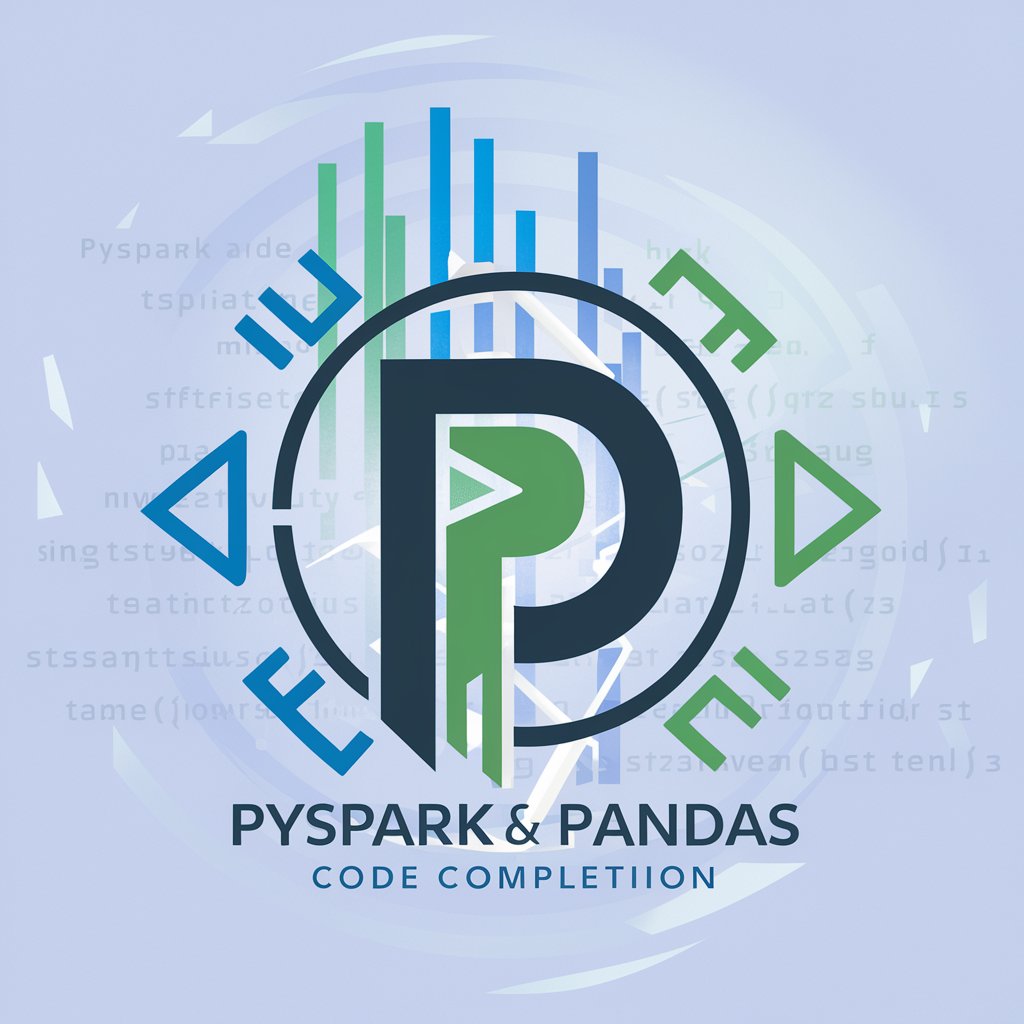pyspark.pandas code completion - PySpark Pandas Autocomplete

Welcome to PySpark and pandas code completion!
Enhance your data projects with AI-powered PySpark assistance
Generate PySpark DataFrame operations that mimic pandas functions.
Create a PySpark script that reads and processes a CSV file using pandas-like syntax.
Explain how to convert a pandas DataFrame to a PySpark DataFrame.
Show how to perform a groupby operation in PySpark similar to pandas.
Get Embed Code
Introduction to pyspark.pandas Code Completion
pyspark.pandas offers a pandas-on-Spark DataFrame, logically equivalent to a pandas DataFrame but optimized for distributed computing using Apache Spark. It's designed to facilitate working with large datasets efficiently, leveraging Spark's distributed data processing capabilities. This enables users to perform complex data manipulations and analyses on big data with familiar pandas-like syntax. Common scenarios include data transformation, aggregation, and complex analytics over large datasets, where traditional in-memory data frames like pandas would be impractical due to the volume of data. Powered by ChatGPT-4o。

Main Functions and Use Cases
DataFrame creation
Example
ps.DataFrame(data=d, columns=['col1', 'col2']) creates a DataFrame from a dictionary.
Scenario
This is essential for initial data loading from various sources, like CSV files, databases, or existing pandas DataFrames, enabling users to start their data analysis workflow on a distributed dataset.
Data transformation
Example
df.filter(items=['col1', 'col2']), df.groupby('col1').sum(), and df.withColumn('col3', df['col1'] + df['col2']) for filtering, grouping, and creating new columns.
Scenario
Useful in data preprocessing, such as cleaning, aggregating, or preparing data for machine learning models. It's particularly beneficial for large datasets where these operations are computationally intensive.
File I/O
Example
df.to_parquet('path/to/output') and ps.read_csv('path/to/file.csv') for reading from and writing to various file formats.
Scenario
Enables interoperability with different data storage solutions, allowing for efficient data exchange between systems and facilitating data pipeline workflows in big data environments.
Statistical functions
Example
df.describe(), df.corr(), and df.cov() for generating descriptive statistics, correlation, and covariance matrices.
Scenario
Important for exploratory data analysis, allowing data scientists to understand distributions, relationships, and data characteristics before applying more complex analytical models.
Target User Groups
Data Engineers
Professionals who build and manage data pipelines, focusing on data collection, storage, and preprocessing. pyspark.pandas helps them handle large volumes of data efficiently, ensuring data is ready for analysis.
Data Scientists
Individuals focused on data modeling, analysis, and statistical research. pyspark.pandas allows them to use familiar pandas syntax on big data, facilitating seamless transition from analysis to production.
Big Data Analysts
Analysts working with huge datasets that traditional data processing tools can't handle. pyspark.pandas enables them to perform complex analyses and gain insights from big data using distributed computing.

Using PySpark.Pandas Code Completion
Start Free Trial
Begin by accessing a free trial at yeschat.ai; this process requires no login and eliminates the need for ChatGPT Plus.
Environment Setup
Ensure PySpark and its dependencies are installed. Verify the presence of a Java runtime environment as PySpark relies on it.
Open Notebook
Open a Jupyter Notebook or any Python IDE where PySpark is configured. Import pyspark.pandas to begin.
Writing Code
Start typing your PySpark code. Utilize the code completion feature to expedite your coding process. It suggests possible code completions based on context.
Testing and Validation
Run your code regularly to test its correctness. Leverage the built-in functions and data structures for efficient data manipulation and analysis.
Try other advanced and practical GPTs
Serious Eater
Your AI-powered culinary guide.

Gordon's Roast
Where AI channels Gordon's fiery feedback

ChessviaGPT Chess Coach | Chat with your account
AI-powered personal chess improvement

ConsultantGPT | Executive Summary for consulting
Transforming Data into Decisions with AI

FinFluencer AI: Trade Ahead
Empowering Your Financial Decisions with AI

Email Guru
Crafting Professional Emails, Powered by AI

AgileGuru by ScrumExpress
Empowering Agile Success with AI

Markus Aurelius
Navigate life with Stoic AI wisdom.

APA Scholar
Streamline Your Citations with AI

UI Asset Generator
Crafting Simplicity with AI-Powered Design

Food from Thought
Tailoring nutrition with AI

はじめての新NISA
Empower Your Investment with AI

PySpark.Pandas Code Completion FAQs
What is PySpark.pandas code completion?
PySpark.pandas code completion is a feature that provides real-time suggestions and auto-completions for PySpark code, enhancing productivity and reducing errors.
Can I use PySpark.pandas without Java installed?
No, Java is required for PySpark since it runs on the JVM. Ensure Java is installed and properly configured in your environment.
How does PySpark.pandas differ from traditional Pandas?
PySpark.pandas is designed for big data processing, leveraging Apache Spark's distributed computing capabilities, whereas traditional Pandas is suited for smaller, in-memory datasets.
Is PySpark.pandas suitable for real-time data processing?
While PySpark.pandas excels at handling large datasets, it's typically not used for real-time processing due to its batch processing nature.
How can I optimize my PySpark.pandas code for better performance?
Optimize your code by selecting appropriate data types, utilizing built-in functions, minimizing data shuffling, and leveraging columnar storage formats.
